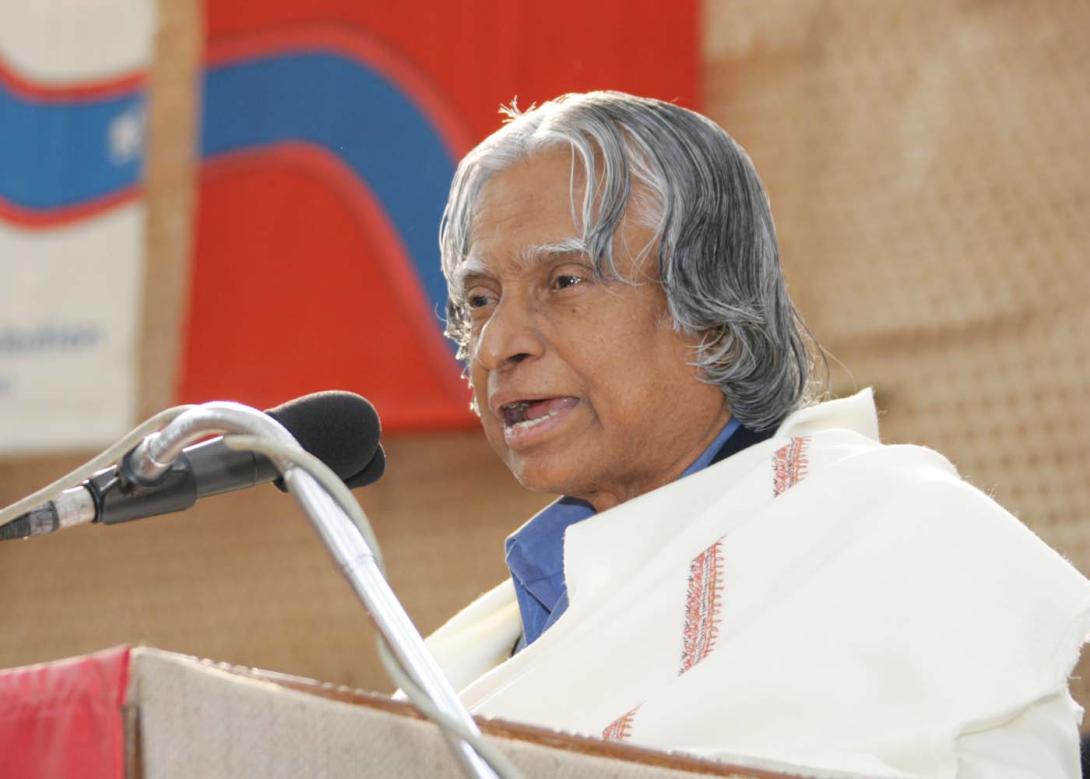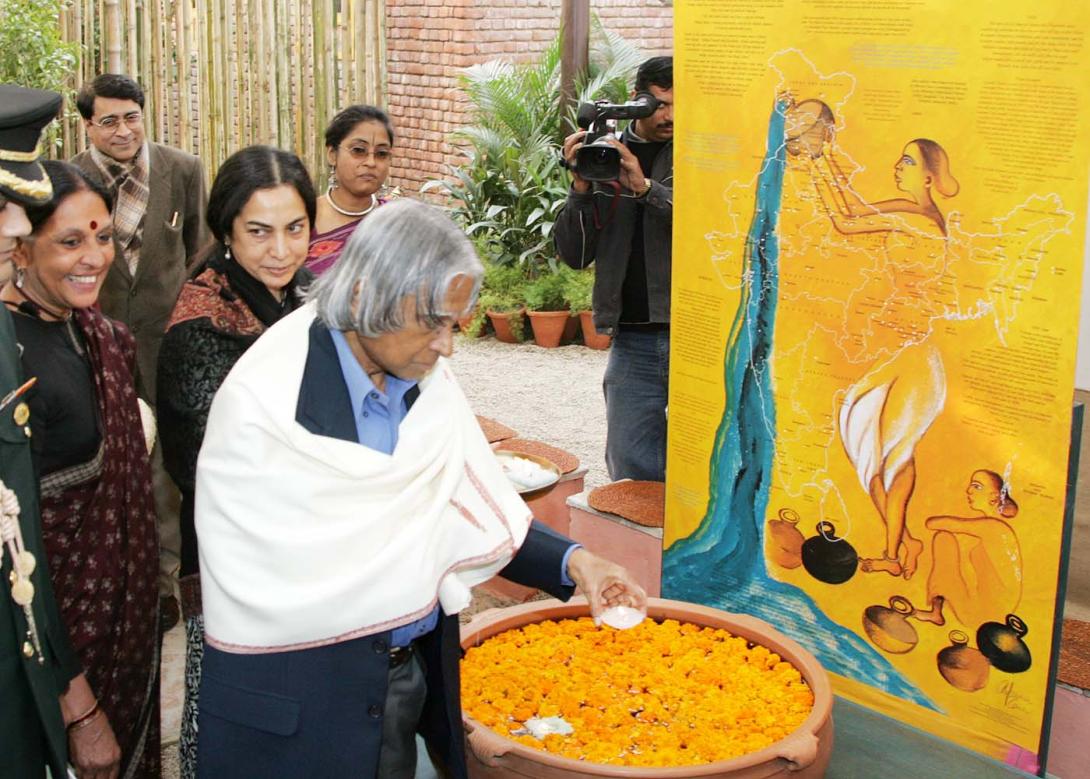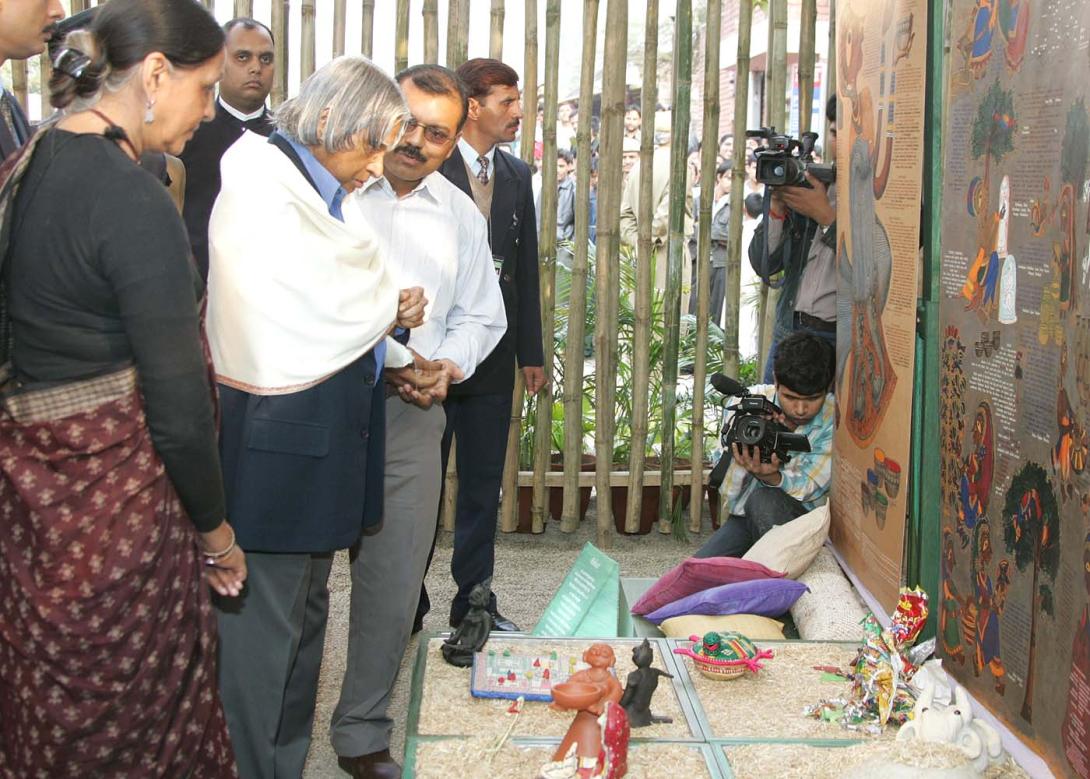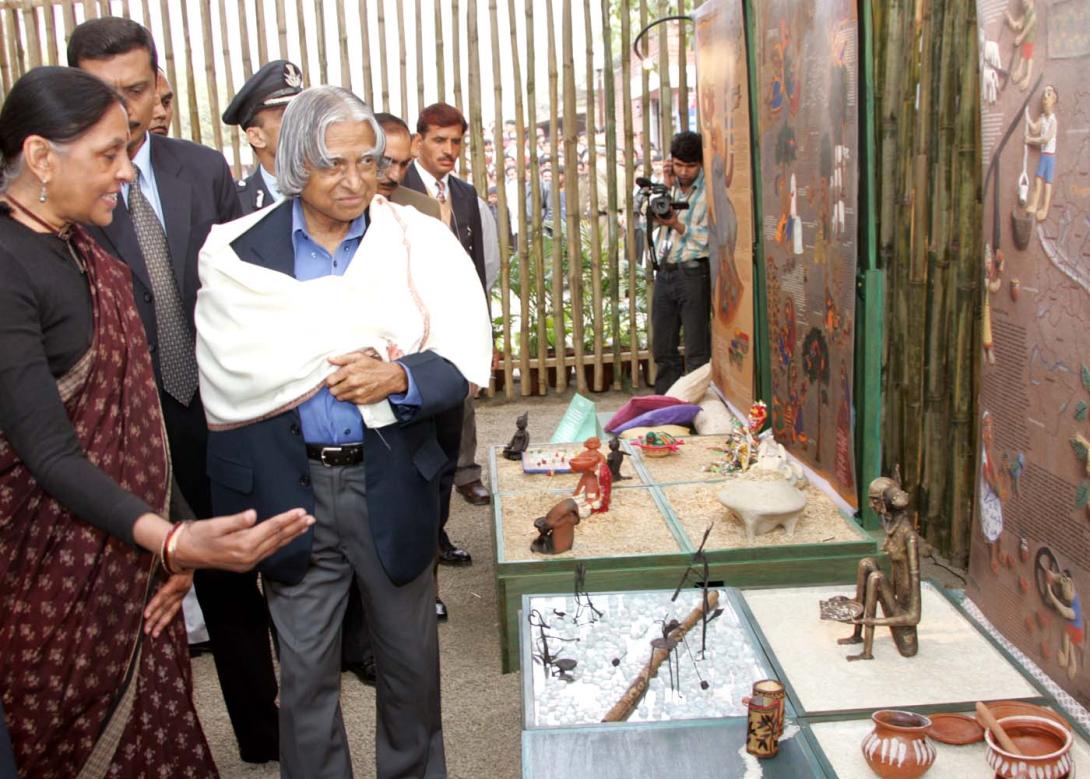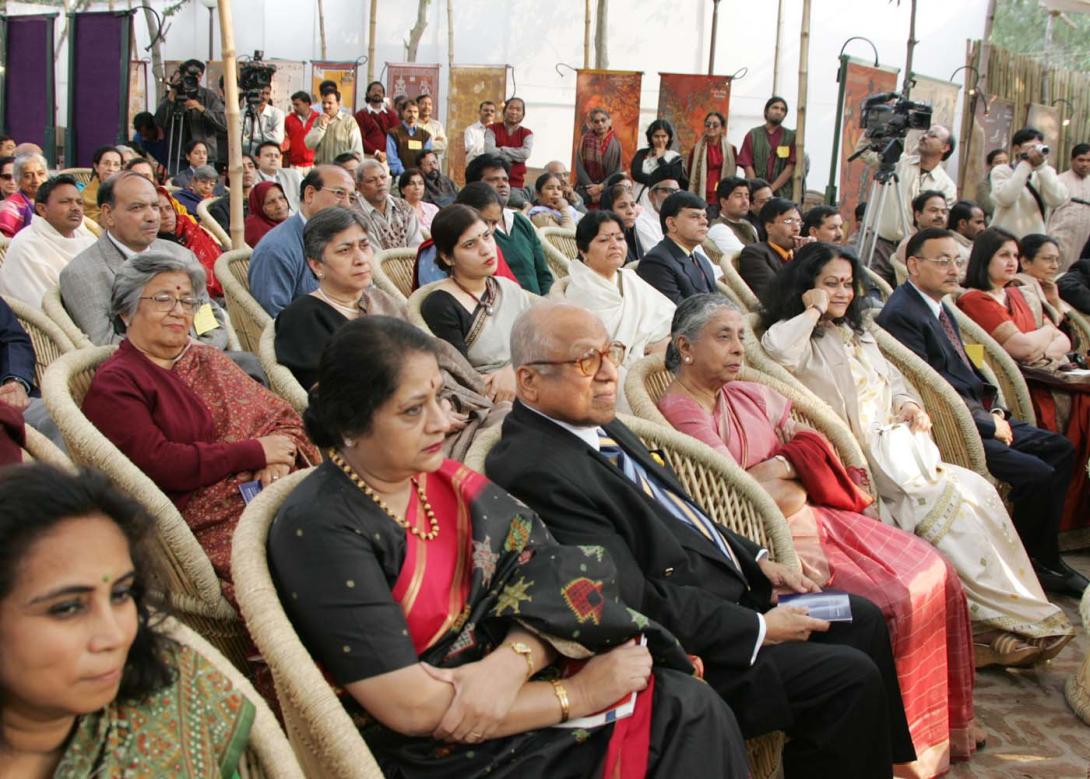Address At The Inauguration Of The Exhibition 'the Indian Crafts Journey'
Delhi Haat, New Delhi : 17-02-2005
How to make Indian Crafts Journey Successful
I am indeed delighted to participate in the inauguration of the Exhibition ?The Indian Crafts Journey? organized by the Dastkari Haat Samithi. I congratulate .the organizers for their excellent contribution in preserving, promoting and enriching the traditional and cultural heritage of our country through the multi-media presentation of artistic maps, crafts and textiles.
Handicraft sector, which provides livelihood to more than 12 million people in our country, plays a significant role in the national economy, as it possesses enormous potential to provide productive employment to large number of craft persons and budding entrepreneurs especially in rural, semi-urban and urban areas and earn foreign exchange through exports by blending traditional heritage craft skill with contemporary development approach.
This exhibition can definitely become a window for creating business opportunity for the artisans.
My experience with Dastkaris
Bhadohi Carpet: Towards the end of 2003 Smt Jaya Jaitly wrote to me about the talented carpet weaver from Bhadohi in Uttar Pradesh named Ramjeet Bind. She mentioned in her letter that Shri Ramjeet Bind has broken all the records in making finely knotted carpets. He was at that time demonstrating weaving and selling his durries at Delhi Haat the present venue of this beautiful exhibition. She wanted to bring Shri Ramjeet Bind to me who had woven a carpet embossed with an interesting image. I agreed to her request and on 1st January 2004 Shri Ramjeet came to me with the framed carpet specimen along with Smt Jaya Jaitly. When I saw the carpet, I was overjoyed with the craftsmanship and the realism he had brought in weaving it. I asked him how much time it took for making this carpet. He said it took nearly three to four weeks for knotting the carpets. I asked him what would be its price. He told me that it was priceless since his whole heart and soul has gone into the creation of this work. When I had a re-look at the carpet, I saw that it was really so. Such is the dedication, commitment and interest shown by many of our weavers and crafts persons engaged in Dastkari work in our country. Since I am in the midst of crafts persons and artisans I thought of sharing with you this incident which really touched my heart.
Sirki Art: One day a craftsman landed in Rashtrapati Bhawan and wanted to see me. I agreed. His name was Shri Mohammed Sageer Mansoori. He belonged to Kasganj, Etah (Uttar Pradesh). He said that he had a special gift of making paintings using Sirki leaves available in the forest. This gift was with him right from his early childhood. He goes to the forest, collects the leaves, presses them in a special fashion so that the insects do not attack and then he sequentially organizes the leaves on hard surface and pastes them using fevicol or dentroid. He showed me few paintings which he has made including a view of the Kutub Minar which was really beautiful. He creates beautiful images and I was fully impressed with the quality of his paintings. He uses certain techniques to enhance the shelf life of his paintings which is around ten years. He told me that he normally takes around a week for completing one painting. The problem he faces is in the marketing of his paintings in the villages. He also needs help in increasing the longevity of his paintings. I would like to discuss the problems faced by such artisans with this gathering.
Status of weavers and craftsmen
We have to look at the major problems that have led to weaver?s pain. This has arisen due to their dependence on the government agencies and certain captive customers for the sale of their products. Inability of these customers to buy from the weavers on a sustained basis had put them into difficulty and created unsold inventories in their godowns.
Time has come for the small scale industries, handloom weavers not to depend on sale entirely through government subsidies. It is important to generate new class of entrepreneur and new class of training. ?Manufacturing locally and marketing globally? must be their motto. For this, they can use many of the recent advances in communication and marketing, including the Internet. When the Roses of Bangalore can be auctioned over the Internet for global supply, why can?t we use the same colourful medium of the Internet for marketing out extremely colourful and aesthetically pleasing products of our weavers and craftsmen through the medium of Internet marketing and E-Commerce. Instead of selling as a cloth they must migrate to selling finished customer products like garments and augment this with innovative marketing ideas. This type of value addition will provide reasonable revenue to the weavers and avoid intermediaries benefiting at your cost.
One of the major problems in our country is that many of the handloom/handicrafts/artisan cooperative societies are not doing well due to competition in the market, non-availability or high cost of raw materials, inadequate finance and lack of information of the supply and demand in the market, lack of quality consciousness and the ethics of the members of the co-operative society.
The state and central governments should analyze the causes of the sickness of the cooperative industries and facilitate them to work with the successful cooperatives, industries and association. In the country we have many successful models like Milk cooperative in Anand, Tirupur knitwear industries, Chatrapatti Bandage Cloth Industries, Ludhiana wool ware etc., These models can be studied and their expertise can be made available through consultancies for reviving the co-operatives, which are in difficulty.
I came to know from my friend Dr. Bowonder who had made a detailed study about the successful experience of silk industry in Kancheepuram and Kolhapuri chappals where technology, training, partnership and marketing have produced spectacular results which, I would like to share with you.
Kancheepuram Story
The silk industry in Kancheepuram is one of the fastest growing industries in India. The industry currently employs more than 30,000 weavers in the art of saree making. The industry had to compete with the synthetic fiber industry in many aspects. The industry was on the brink of extinction due to the obsolescence of the designs and design making procedures. This is because, design adds splendor to a saree and forms an integral part of its exquisiteness. Introduction of computerized Jacquard borders in Kancheepuram silk saree has helped in the revival of the industry. The use of ICT has not only helped in creating new and complex designs but also reduced the time involved in the design. There has been an increase in the exports. The acceptance of these silk sarees by the consumers has also increased with the automation of designing process. Visualization of saree designs ahead of its production and the ability to create new color combination at the click of a mouse has increased the flexibility and reduced the time for realizing new designs. Though the materials and the techniques are changing with the market demand, the motifs are still conventional to hold the custom and tradition of the Kancheepuram saree. The silk industry in Kancheepuram has transformed into a high growth industry by opening up new avenues for the traditional weavers. The example illustrates that computer aided design can help renewal of a traditional industry provided the new technology is simple to use and users are trained properly.
Leather industry
Leather industry is a traditional industry. Kolhapuri is a traditional chappal manufactured through a manual process. This is a case study of the manner in which the design process, manufacturing process and marketing was reengineered using ICT interventions. Use of ICT helped this industry to reposition itself. The main reason for the early adoption and rapid diffusion of the new technology has been the systematic training carried out by Central Leather Research Institute for imparting skills in the local craftsman using two people from the same community. The income of craftsman increased considerably after the adoption of ICT for designing and market access. The production increased from about 20 pairs per week to almost 200 per week. CLRI also helped in changing the manufacturing process such that the productivity has gone up apart from the use of computer aided design. The designs have shown a quantum jump both in terms of quality and variety. The whole project was implemented under the National Leather Technology Mission. An NGO from Bangalore helped in selling the Chappals on line thereby enhancing the price realization. The exports have shown an increase. On the whole this is an exciting experience of using new technology to reengineer and renew a traditional industry. The main reason for the success has been the training of the local craftsman by CLRI. This model should be replicated across the country by the industry, academia, non-government organisations and the village bodies. State and Central Government should proactively facilitate nurturing of the industry.
Knowledge powered rural complex
The work of craftspeople and artisans is the result of creativity. Creativity comes from traditional knowledge. However this traditional knowledge and skill need to be upgraded through research and development and integrated with technology for sustainable development of this sector. We are all aware of the various constraints being faced by this industry such as non-availability of adequate quality raw material in time, lack of timely credit facilities, lack of training for using modern technological applications, inadequate organizational and marketing support and services etc. I am happy to know that in order to address these challenges and empower the craft persons and weavers, a few schemes have already been launched in partnership with State agencies, voluntary organizations, national institutes and entrepreneurial community. The problems about how to market with value addition the finished products of craftspeople, how to integrate multi departments and provide assistance in an integrated way can be addressed with the concerted efforts and techno-commercial assistance of all agencies like local self-help groups, panchayat and co-operative societies. Instead of craft persons and weavers coming to urban marketing centres, the reverse phenomena have to take place. Delhi Haat attracts lot of craft persons from all over the country. It is a good success story. It should be spread in many district and taluk levels.
Conclusion
Craft persons and weavers are an important component for our upliftment of rural economy. Over 12 million people are earning their livelihood from this industry. For example, in Nagaland and Arunachal pradesh every house weaves, knits and produces gadgets using the animal horns and other natural inputs and become a family craft centres. Most of the items are used by themselves and rest of them they sell in the barter basis in the local markets. We have seen some island of success and number of problems faced by the industry as a whole. Concerted action is needed to promote this cottage industry into a thriving wealth generator bringing prosperity to rural craftspersons and weavers.
I would suggest that the concerned State and Central ministries in the textile, handicrafts and artisans domain can have five point programme to bring vibrancy to this sector in partnership with NGOs, R&D Centres, Academia and other industries:
1. Identify the core strength of the village cluster and infuse the technology to the relevant weavers, craftsmen and artisans
2. Create core strength specific vocational training centres value added with state-of-the-art technology at district/Taluk level including mobile quality assurance service centres.
3. Create a consortium of Industry, R&D, academia and successful co-operative societies which can provide consultancies on total business development in the village cluster
4. Create entrepreneurial training centres for promoting craftsmen, weavers, artisans into successful entrepreneurs to manufacture locally and market globally
5. Expose internet method of marketing to the village industry and provide right kind of buy back arrangements, through village knowledge centres.
This exhibition, I am sure is one effort towards increasing the marketability of our handicrafts and textile products. I wish the participants success in their mission of promoting our traditional art system leading to sustainable wealth generation in the rural sector.
May God bless you.

